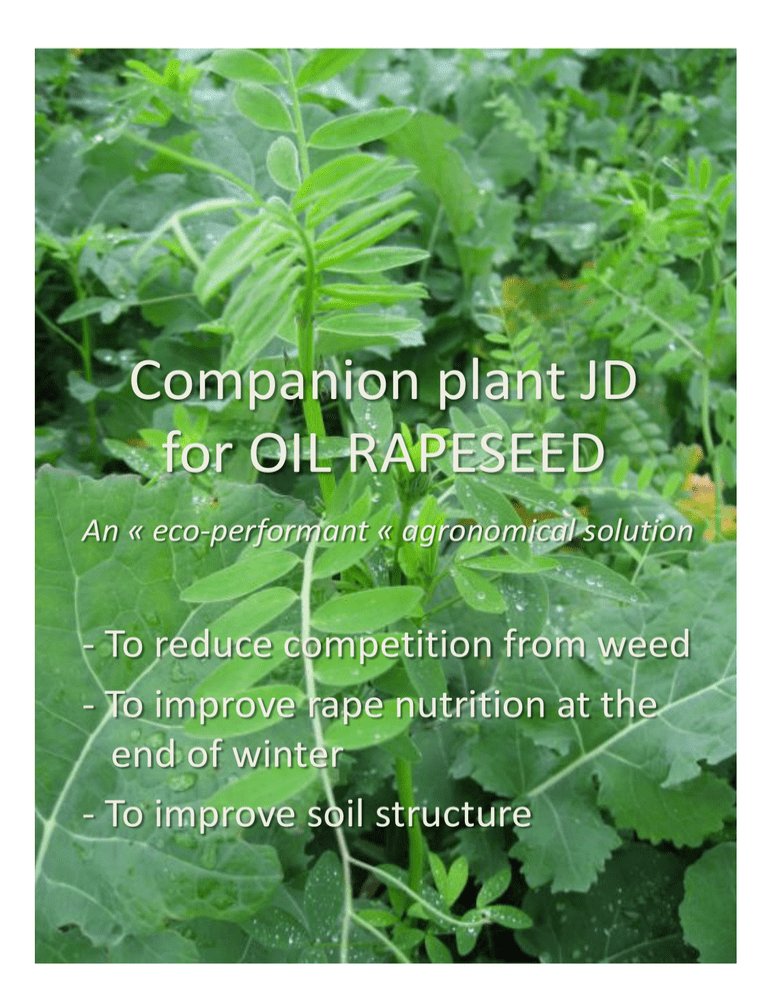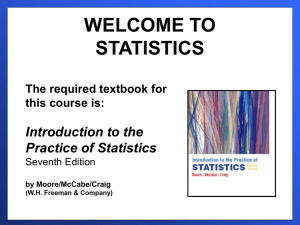Plante compagne JD R COLZA
advertisement

Companion plant JD for OIL RAPESEED An « eco-performant « agronomical solution - To reduce competition from weed - To improve rape nutrition at the end of winter - To improve soil structure What is a compagnion plant? Sowed at the same time than the main crop, companion plants allows a significant yield improvement. Initially developed for oil rapeseed, JD is also currently working on finding solution for other crops as well such as winter cereals, maize and sunflower. SOWING Mixture of COMPANION PLANTS HARVESTING CROP COMPANION PLANTS What targets are we aiming to reach with companion plants on oil rapeseed ? The added value brought by legumes sowed in association with oilrape seed has now been demonstrated. The targets of this technique are the following : 1- Reduce the competition of weeds on rapes 2- Secure the nutriments availability for rapes at the end of winter 3- Improve soil structure on the first 20 cm How did Jouffray-Drillaud did select the varieties of companion plants for oil rapeseed ? Based on our strong expertise in intercrop covers, Jouffray-Drillaud has started several years ago a research and development program dedicated to companion plants for oil rapeseed. This selection program aims to create the optimal varieties within the best possible species range for the specific use of companion plant. The first target is to increase the rape yield thanks to its association with other plants. Legumes have strong agronomical advantages and therefore are the base of our companion plant program where variety characteristics are as important as the species. What characteristics do we select for companion plants of oilrape seed? • A fast and early growth • An important covering power but which at the same time should not compete with rape • High sensitivity to frost • A good mineralisation ability at the end of winter (Low C/N ratio) • A low TGW (thousands grains weight) for an easy drilling in association with rape Jouffray-Drillaud Cultivation advise : Can this new technique fit to all situation ? It is advised to be careful on lands where there is a high weed pressure, especially with broadleaved plants such as : géraniums, mayweed, cleaver…etc. An appropriate weed control strategy should be adopted especially in difficult situation. The way the soil is worked out is also an important factor. In case of direct drill, the weed pressure is lower and the companion plant technique then has increased chances of success. Companion plant effect on the development of geranium (weed) on oilrape seed crop – direct drill (2009) Low weed risk Intermediate Strong weed weed risk risk Classical plowing Smart weed control strategy needed Not advisable Simplified agronomic techniques Smart weed control strategy needed Not advisable Geranium qty (g/m²) Nbre of geranium /m² Direct drill Rape Rape + Compagnion plant When should I sow? Sow early - In order to support the growth of both rape and companion plant - In order to increase the legumes frost sensitivity as they will be at a more advanced development stage. 20/08 au 01/09 25/08 au 05/09 20/08 au 05/09 25/08 au 10/09 How should oil rapeseed and companion plants be drilled? A simultaneous drilling in one single go is advisable when equiped with a double hopper drill or even by mixing the rape and the companion plant seed together in the drill. In this last case, the mix of different type of seeds gives additional fluidity . Sowing in two steps can also be done : first sow the companion plants with reduced seed row gap and then seed the rape (precision drill or striptill) Which weed-killing strategy should I go for ? Weeding strategy should be defined and decided according to the weed risk and the cultivation techniques which are being used. The companion plant covering effect will reduce sgnificantly the weed pressure in autumn. However, this technique cannot replace a weeding in difficult situations. Therefore, the weed-killer chosen should be efficient against weed and respectcfull of the companion plants. New weed-killers which are currently under registration process for post-germination use, are being tested. They could be an interesting solution in the future for rapeseed associated with companion plant. High weed pressure risk situation Low weed pressure risk situation Pre germination Post emergence Program 1 Novall 0,5 to 0,7 L/ha Novall 1 L/ha Program 2 Butisan 1L/ha Butisan 1L/ha Program 3 Sprinbok 1,5L/Ha Novall 0,5L/Ha Program 4 Novall 1 L/ha (early) Program 5 Lontrel 1L/ha or Callisto 0,15 L/ha An anti graminea weeding intervention may be advisable depending on situations . In case companion plants are not destroyed by frost, they can be removed with Lontrel at low dosis 0.3 to 0.4L What fertilization? This companion crop is composed of a legumes assortment and is destroyed by frost during winter. It then release some 30 to 40 units of nitrogen to the main crop (winter oilseed rape). This additionnal nitrogen supply is due to : - The mineralization of the plants (leaves and roots) in the ground. - An improved rooting system of the rape thanks to the action of the rooting system of the companion plants - A global improvement of the soil fertility. The rape benefits from its companion plants till flowering and permit a reduction of nitrogen fertilisation. Depending on climatic conditions, companion plants provide up to +20% of growth to the rapeseed at stage F1/G1. The mineralization and nitrogen restitution process is directly linked to the C/N ratio of the selected companion plants. + + X VETCH Mineralized N Release C/N X Berseem clover - C/N + - Nitrogen Release time + Is their any effect on insects that create damages on oil rapeseed ? Several measurements and observation could be done, showing encouraging results on insects behaviours on rape, when companion plants are present. We could observe less insect attacks. These observation are particularly valid in autumn for altises and flea beetles which are disturbed during their laying season. However, a certain level of watchfullness should be observed and any intervention decision should take into account the insect pressure level. Do companion plant influence the level of fungal disease on oil rapeseed? It was not observed any increase of diseases specific to oil rapeseed, such as schlerotinia, when companion plants are present. When peas are part of the rotation, it is advisable to go for varieties that are not sensitive to aphanomice such as lentils. And what is the outcome ?... For the past 3 years, very encouraging results could be observed in experimental slots as well as in the fields. Aditionnal yields of about 300 kg /ha could be obtained in comparison to oil rapeseed alone. These performances can be explained by an increase in the number of pods per m². Yields in 100 kg / ha Relations between the volume of green matter at flowering and yields Volume of green matter at flowering (kg/m²) Direct drill – Rapes + Comp. plants No direct drill – Rapes + Comp plants Direct drill – Oil rapeseed alone No direct drill – Oil rapeseed alone Autumn % species Nbre of seed/m2 48 20 Red vetch BINGO 32 17 Berseem clover TABOR 20 160 Common vetch, very early, NACRE •Less weed • Rape grows faster •The rape develops stronger roots Winter ADVANTAGES OF THE MIX •Fast ground covering = less weed, less herbicides • Secured growth (3 species) •Improvement of the soil structure, thanks to the strong roots of these 3 legumes •Excellent nitrogen releaseto the oilseed rape •Increased soil fertility (legumes effect) •Varieties easily destroyed by frost Yield in % of reference Rape variety JIMMY (½ early) Yield 3,44 tons / ha Companion plants destroyed by frost At the end of winter Improved nitrogen nutrition when the rape starts growing again Before harvesting Companion plant JD PC1 Berseem clover + medic + hairy vetch Common vetch + hairy vetch Lentil + fenugrec+ gesse Higher yields







